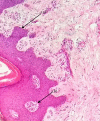Human papillomavirus, Epstein-Barr virus, and Candida albicans co-infection in oral leukoplakia with different degrees of dysplasia
- PMID: 34101999
- PMCID: PMC8543472
- DOI: 10.1002/cre2.435
Human papillomavirus, Epstein-Barr virus, and Candida albicans co-infection in oral leukoplakia with different degrees of dysplasia
Abstract
Objectives: To identify human papillomavirus (HPV), Epstein-Barr virus (EBV), and Candida albicans in oral leukoplakia with different degrees of dysplasia.
Materials and methods: An observational, cross-sectional, descriptive study was performed using 30 formalin-fixed and paraffin-embedded tissues from patients with clinical suspicion of leukoplakia and confirmed diagnosis of oral dysplasia. Histological analyses were performed by two pathologists (interobserver) and dysplasias were classified as mild, moderate, or severe. Conventional PCR was used to detect HPV and EBV viruses and C. albicans. To determine the association between each microorganism with different degrees of dysplasia a Chi-square test was employed.
Results: The tongue was the most common site for leukoplakias (71.4%) in females with a mean age of 50 years (ranging between 30 to 50 years old; 57.1%). EBV was the most frequently detected (73.3%), followed by HPV (43.3%), mainly of type 16 (40%), and C. albicans (23.3%). Significant differences were observed between degrees of dysplasia and HPV presence (p = 0.005). In lesions positive for HPV, EBV, and C. albicans the most frequent histological changes were hyperkeratosis, irregular interpapillary ridges, and loss of basal stratum cell polarity.
Conclusion: Co-infection with human papillomavirus, Epstein Barr virus, and Candida albicans in oral leukoplakia could be associated with dysplastic changes.
Keywords: Candida albicans; Epstein-Barr virus; Human papillomavirus; dysplasia; leukoplakia.
© 2021 The Authors. Clinical and Experimental Dental Research published by John Wiley & Sons Ltd.
Conflict of interest statement
The authors declare there is no conflict of interest.
Figures





References
-
- Acharya, S. , Ekalaksananan, T. , Vatanasapt, P. , Loyha, K. , Phusingha, P. , Promthet, S. , Kongyingyoes, B. , & Pientong, C. (2015). Association of Epstein‐Barr virus infection with oral squamous cell carcinoma in a case‐control study. Journal of Oral Pathology and Medicine. 44(4), 252–257. 10.1111/jop.12231 - DOI - PubMed
-
- Aguas, S. , & Lanfranchi‐Tizeira, H. (2004). Lesiones premalignas o cancerizables de la cavidad oral. Revista de La Facultad de Odontología (UBA), 19, 21–30. http://www.odon.uba.ar/revista/2004vol19num47/art4.pdf
-
- Angiero, F. , Gatta, L. B. , Seramondi, R. , Berenzi, A. , Benetti, A. , Magistro, S. , Ordesi, P. , Grigolato, P. , & Dessy, E. (2010). Frequency and role of HPV in the progression of epithelial dysplasia to oral cancer. Anticancer Research, 30(9), 3435–3440. - PubMed
Publication types
MeSH terms
Grants and funding
LinkOut - more resources
Full Text Sources
Medical

